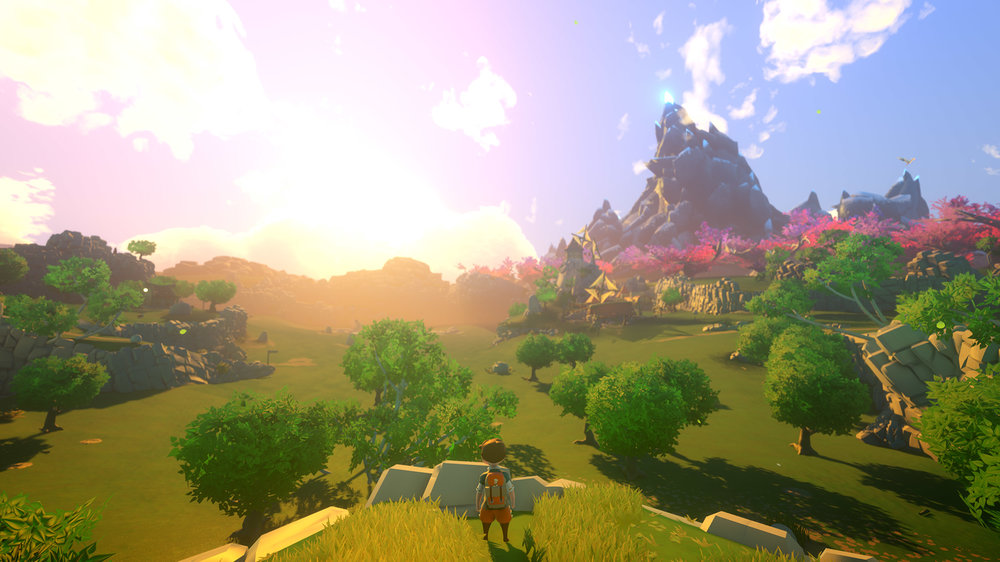Yonder: The Cloud Catcher Chronicles spends its first fifteen minutes invoking memories of two of the best Zelda games. It opens on a boat, with your player-created character and a cartoony crew sailing through choppy seas, heading towards a distant island. It’s a scene reminiscent of
The Wind Waker’s early moments, when Link and Tetra first set sail together. Soon enough the ship is wrecked, and you wash up on the shore of Gemea, the island nation the game is set across. After a brief tutorial the game offers a near-direct copy of Link’s emergence at the beginning of Breath of the Wild, as our character runs to a precipice and the camera pans back to reveal the wider world, the soundtrack underscoring the grandiosity of the moment.
It’s a bold move, but while the experience that follows invites comparisons to Breath of the Wild’s invitation to explore, Yonder plays very differently from Nintendo’s masterpiece. This is an extremely relaxed game, one with no combat, few puzzles to solve, and no danger of death at any point (you can ‘drown’ if you jump into deep water, but you’ll immediately spawn back on dry land with no repercussions).
You’re placed on this island and given, for the most part, free reign: after the first few missions grant you all of the game’s essential tools you can either follow the main quest line or set out on your own path.
The plot is extremely thin–a darkness (called the “murk”) has spread over the world, and it’s up to you to get rid of it by completing a bunch of fetch quests. The murk doesn’t manifest as a threat, per se, and is instead used to justify the emptiness of the game world, which is filled with wonderful vistas but very few people to enjoy them.
The islands of Gemea are loaded with quests, but the majority of them involve little more than gathering resources. Yonder is a game of exploration–the game world is sizable, and there is barely a ‘quick travel’ system, offering only a few unlockable warp points.
The quests you pick up will usually guide you towards the part of the map you need to head to next, but figuring out how to get there–which paths to take up which mountains, which caves to traverse, which roads to take through which clearings–is on you. By the end of the game, you’ll likely find you have a much better sense of where things are, and how to get to them, than you usually do in open world games.
Along the way you’ll want to pick up anything not nailed down, so that when you find an NPC with a side quest there’s a good chance that you’ll already have the things they wanted you to gather (and if not, you’ll hopefully have enough to swap with a local merchant–the game has a barter economy).
Some of these quests can be quite involved. One late in the game, for instance, asks you to collect a certain item from a cave, but to find that cave you’ll need to craft a bomb (it makes sense in context).
To get the materials to make that bomb, you’ll need to first become a ‘brewer’, which requires that you head to another part of the map and complete a different quest to open up new crafting options. After that, you’ll get the recipe required to create the parts you need in the ‘crafting’ menu, which tells you exactly what you can build and what you’ll need to build it.











This is one of the game’s more complicated quests, though, and most are far simpler. Yonder is not designed to be challenging. The main quest line is extremely short; tellingly, the trophy awarded to you for completing the final mission is called “That was easy”.
This pace can actually be refreshing, but once that main quest is complete the appeal of having a beautiful island to wander around starts to wane. The side quests aren’t necessarily much fun, and the rewards for completing them are often intangible, offering little more than a sense of satisfaction that becomes less satisfying with each new item ticked off your quest list.
Search the world high and low, uncovering its secrets, and it will rarely feel like the game world has actually changed in any way that matters, even after you’ve finished the game. Once you’ve seen everything and the appeal of exploration wears off, there’s little reason to push for 100% completion.
There’s a farming system, too, which lets you establish farm plots and generate income by housing livestock (if you walk up to an animal while you happen to have its favourite food in stock you’ll have the option of feeding it, and after that it’s yours).
This could be the game’s deepest mechanic, but it feels weirdly inconsequential. Farms serve a practical purpose–they let you store resources, which is good when your backpack fills up–but farming is not exactly a deep experience, and it’s not going to pull anyone away from Stardew Valley.

Yonder is beautiful and relaxing, but only up to a certain point. It’s great for the first few hours, wandering around and discovering new sights, but the world ultimately leaves you wanting more depth and personality to explore.
The NPCs you encounter aren’t fleshed-out characters, and the villages scattered throughout Gemea feel like veneers rather than actual locations–there are no building interiors, and very little sense of the lives being lived within them. Yonder is full of beautiful views, but while a distant mountain might be stunning, after a few hours it’s hard to get excited by what might be on the other side of it.

